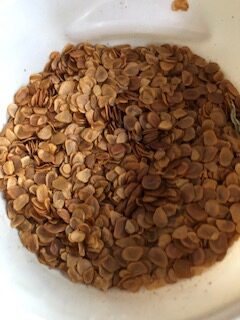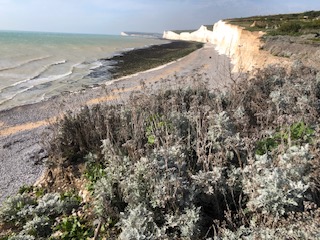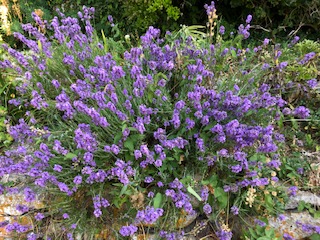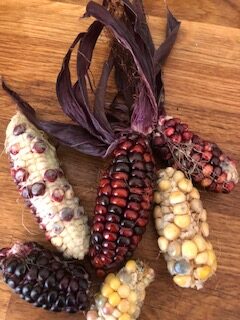Wondering what to write about this week, I asked my husband for suggestions. ‘Seeds,’ he said and then went on the extol their miraculous qualities and how they act as a rather apt metaphor for life. Seeds? I thought. How on earth am I going to find 1,000 words to write about seeds?
My husband, a newly converted gardener, is currently fascinated by seeds. After planting vast numbers of tulip bulbs, he discovered that they can be propagated by seed. (Who knew?) He then went on to find that if you harvest these seeds, plant them and wait about three years (gardening is not for the impatient) you will get tiny bulbs. Having found that all bulbs can be grown from seed, he then deseeded my giant lilies. And here they are:

Image: Karen Costello-McFeat
If anyone would like some, let me know!
All flowering plants begin as seeds, though some will multiply from there by other methods. For example, strawberries and spider plants reproduce from runners or ‘daughter plants’, which are attached to the parent. I was delighted to discover another wild strawberry plant when weeding in the garden, and my plan is to let them take over the entire area. But overcrowding for plants and people is seldom wise, so strawberries also have berries with the seeds on the outside to give them the opportunity to disperse their seed further afield.
Here’s a little video about the life cycle of plants. It is rather cartoonish, but I confess I could have used such a clear presentation when doing O level biology. (Please skip if you know all this already!)
Free gifts
My perambulation around the garden yesterday brought lots of surprises. Seeds had clearly been having a good time exploring new parts. The rocket is incredibly successful at long distance travel and has made it from my veg patch at the far end of the back garden to the front lawn. I was delighted to find new clumps of parsley yards from where they were sown; flowers that hopped up into my raised garden planters and some that had found a location they preferred away from their original beds. Such unexpected gifts are always a joy and if you are not too fussy about keeping your garden in regimented order, it will soon decide where plants are most comfortable and will thrive. We practise a very relaxed version of forest gardening and it certainly works for us.



Autumn’s glory
To compensate for the paucity of flowering plants in this season, autumn generously offers us an alternative. Seed heads are a beautiful addition to any scene and particularly enchanting in autumn’s slanting light. Their delicate silhouettes act as an elegy to summer. For now, they are bare: mere mementoes of warmer days. But in holding the seeds for future seasons, they promise a return to colour and abundance.

Seed heads also make the loveliest displays. I have several in vases throughout the house and some giant allium heads woven through with tiny lights so they look like illuminated chrysanthemums. When fresh cut flowers are not in season, these make the most environmentally friendly alternative.
Feed the birds
Seed heads are a great food source for birds during the lean autumn and winter months. That said, we often tidy the garden and get rid of many of those nutritious food sources, since those ‘dead’ twiggy, stems are less beautiful (at least to some). Reading an edition of Country Living recently, I discovered that some plants we routinely cut back are great bird feeders and will thrive just as well with a spring as an autumn trim. Though this information was too late for some of my lavender, the rest is still flower heavy and I’m trying to be careful only to take out those plants whose seeds have already been eaten or dispersed.

Image: Karen Costello-McFeat
Harvesting seeds
Harvesting seeds could hardly be simpler. One only has to pick the plants (dry if necessary) and shake them out onto paper and transfer to a paper bag. That’s it. I like to make pretty seed envelopes for seeds to share, but just because I like an excuse to play.
This year I am drying my Indian corn kernels. My corn this year didn’t fare well. First they were assaulted by snails, then happily grew during the long, warm spell, only to be assaulted once again, this time by torrential rain and a plague of woodlice. Never mind. Such things are inevitable in gardening. Luckily, they were able to produce just enough to give me seeds for next year. I must let them dry completely then gently pick off the kernels. I’m hoping that the weather and wildlife will be kinder then.

Image: Karen Costello-McFeat
Enough to share
Though seeds are not expensive, they are not especially cheap either – especially for more rarefied varieties as the corn above. When you gather your own seeds, there is always more than enough to go around. Last year, I gave out sunflower and corn seeds and hope they fared better than mine! Many towns will have seed swaps during the autumn, but less formal exchanges between friends is also great. Whatever knowledge you have acquired about location, soil and conditions can be passed on with the packet of seeds.
Planting seeds is an act of hope and, as any gardener will tell you, results in great joy when successful. My husband made a lovely comparison between planting seeds and life. He said, you plant so many, but only a few will make it to completion. Like all endeavours, we work hard and don’t always achieve the outcomes that we hope for. That said, when they do materialise, our labours bloom delightfully and all the effort seems worthwhile.
